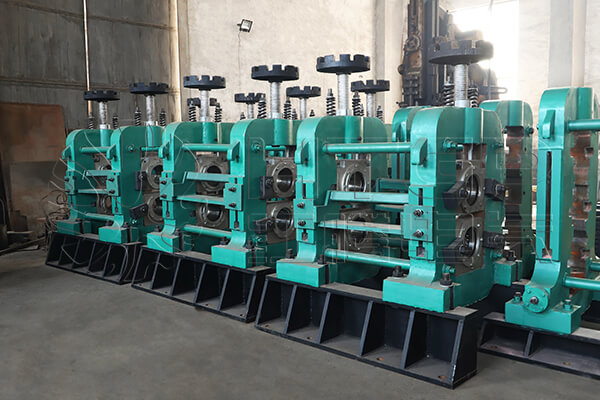Common Malfunctions and Treatment Methods in Steel Bar Production Line
In the steel bar production line, there are various malfunctions occurring during production, such as the billet failing to enter the rolling mill, steel billets stacking before the rolling mill, and the rolled pieces being pulled to break. These malfunctions can seriously affect the efficiency of the steel bar production line. So, how to deal with these faults in the steel bar production line? Today, Luoyang Hongteng will introduce you in detail.

Rolled Piece Fails to Enter the Rolling Mill
Causes
Rotten head, split head, blackhead, etc. of the rolled piece; incorrect or too small installation of the inlet guide; sticky iron or foreign matter in the inlet guide; too large or too small turning angle of the rolled piece; rolling guide wheel does not turn Or the bearing is burned out; the roll does not rotate due to fracture or connection; the roll gap is not adjusted properly or the size of the incoming material does not meet the requirements; the friction coefficient of the rolling pass is too small (new pass), etc.
Analysis, Treatment, and Preventive Measures
-
1. Analyze the reasons for the non-feeding of the rolled pieces, strengthen the inspection of the head defects of the rolled pieces, and deal with them in time;
-
2. After the entrance guide is installed, use an internal caliper to measure the width of the entrance cavity; use light to illuminate and check from the exit direction whether the entrance guide is aligned with the hole type and fasten the guide bolts;
-
3. Use a caliper to check and measure the actual size of the rolled piece to ensure that the size of the incoming material is correct;
-
4. The size of the roll gap is strictly adjusted according to the rolling requirements;
-
5. Frequently inspect the rolling guide wheel and the twisting outlet and replace them in time; frequently check the inlet guide plate for iron filings, silted iron scale, or sundries;
-
6. The new pass type should be tested with small materials first.
Steel Billets Stack before the Rolling Mill
The pile-up failure of rolled pieces refers to the phenomenon that the rolled pieces stagnate after being piled up in the rolling mill or among the rolling mill units, which is called pile-up failure.
Causes
-
1. The incoming material size and cross-sectional area of the rolled piece are too large; the rolled piece itself has surface or internal quality defects;
-
2. The friction coefficient of the roll pass is not enough, causing the rolled piece to slip;
-
3. The second volume flow rate of the incoming rolling mill is greater than the second volume flow rate of the receiving rolling mill;
-
4. The electrical control system is faulty or out of control.
-
5. The mechanical running part of the automatic looper system or the photoelectric control instrument is installed incorrectly, out of control, or malfunctioning.
Analysis, Treatment, and Preventive Measures
-
1. Adjust the size and area of the incoming material to meet the reasonable continuous rolling constant relationship;
-
2. Dynamically and closely monitor the operation status of the rolled piece and adjust it in time;
-
3. To ensure the quality of the steel billet entering the furnace; to deal with the semi-finished products with quality defects in time;
-
4. Regularly check the rotation speed of each rolling mill, the looper system, and the electrical control system to ensure that the operating equipment and the electrical control system are stable and normal.
Rolled Pieces Are Pulled to Break
Rolled steel drawing failure refers to the phenomenon that the rolled piece is too tight or broken in the rolling mill or between the rolling mill units, which is called drawing steel failure. Due to the failure of steel drawing, the size of the rolled piece often changes, and in severe cases, it even leads to the out-of-tolerance of the finished product’s outer dimension or out-of-roundness, resulting in waste.
Cause
-
1. The incoming material size and sectional area of the rolled piece are too small;
-
2. The second volume flow rate of the incoming rolling mill is less than the second volume flow rate of the receiving rolling mill;
-
3. The electrical control system is faulty or out of control.
Analysis, Treatment, and Preventive Measures
-
1. Adjust the size and area of the incoming material to meet the reasonable constant rolling constant relationship.
-
2. Ensure that electrical appliances and electronic control equipment systems operate normally.

